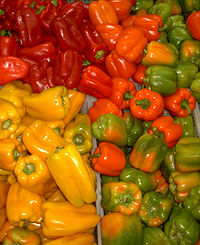Bell pepper
| Bell pepper | |
|---|---|
 |
|
| Red, yellow and green pepper | |
| Scientific classification | |
| Kingdom: | Plantae |
| (unranked): | Angiosperms |
| (unranked): | Eudicots |
| (unranked): | Asterids |
| Order: | Solanales |
| Family: | Solanaceae |
| Genus: | Capsicum |
| Species: | C. annuum |
| Binomial name | |
| Capsicum annuum L. |
|
| Heat | None (SR:0) |
|---|
| Nutritional value per 100 g (3.5 oz) | |
|---|---|
| Energy | 84 kJ (20 kcal) |
| Carbohydrates | 4.64 g |
| Sugars | 2.40 g |
| Dietary fiber | 1.7 g |
| Fat | 0.17 g |
| Protein | 0.86 g |
| Thiamine (Vit. B1) | 0.057 mg (4%) |
| Riboflavin (Vit. B2) | 0.028 mg (2%) |
| Niacin (Vit. B3) | 0.480 mg (3%) |
| Pantothenic acid (B5) | 0.099 mg (2%) |
| Vitamin B6 | 0.224 mg (17%) |
| Folate (Vit. B9) | 10 μg (3%) |
| Vitamin C | 80.4 mg (134%) |
| Calcium | 10 mg (1%) |
| Iron | 0.34 mg (3%) |
| Magnesium | 10 mg (3%) |
| Phosphorus | 20 mg (3%) |
| Potassium | 175 mg (4%) |
| Zinc | 0.13 mg (1%) |
| Percentages are relative to US recommendations for adults. Source: USDA Nutrient database |
|
Bell pepper or sweet pepper is a cultivar group of the species Capsicum annuum (chili pepper). Cultivars of the plant produce fruits in different colors, including red, yellow and orange. The fruit is also frequently consumed in its unripe form, when the fruit is still green. Bell peppers are sometimes grouped with less pungent pepper varieties as "sweet peppers". Peppers are native to Mexico, Central America and northern South America. Pepper seeds were later carried to Spain in 1493 and from there spread to other European, African and Asian countries. Today, Mexico remains one of the major pepper producers in the world.
Contents |
Nomenclature
The misleading name "pepper" (pimiento in Spanish) was given by Christopher Columbus upon bringing the plant back to Europe. At that time peppercorns, the fruit of Piper nigrum, an unrelated plant originating from India, were a highly prized condiment; the name "pepper" was at that time applied in Europe to all known spices with a hot and pungent taste and so naturally extended to the newly discovered Capsicum family. The most commonly used alternative name of the plant family, "chili", is of Central American origin. Bell peppers are botanically fruits, but are generally considered in culinary contexts to be vegetables. When cut off, the top of the bell pepper is referred to as a "pepper pan".
While the bell pepper is a member of the Capsicum family, it is the only Capsicum that does not produce capsaicin,[1] a lipophilic chemical that can cause a strong burning sensation when it comes in contact with mucous membranes. The lack of capsaicin in bell peppers is due to a recessive form of a gene that eliminates capsaicin and, consequently, the "hot" taste usually associated with the rest of the Capsicum family.[2]
The term "bell pepper" or "pepper" or "capsicum" is often used for any of the large bell shaped capsicum fruits, regardless of their color. In British English, the fruit is simply referred to as a "pepper", or additionally by colour (as in the term "green pepper", for example), whereas in many Commonwealth of Nations countries, such as Australia, India, Malaysia and New Zealand, they are called "capsicum". Across Europe, the term "paprika", which has its roots in the word for pepper, is used—sometimes referred to by their color (e.g., "groene paprika", "gele paprika", in Dutch, which are green and yellow, respectively). Paprika also refers to the powdered spice made from the fruits in the capsicum family.[3] In France it is called "poivron", with the same root as "poivre" (meaning "pepper"), or "piment". In Japan, the word ピーマン ("pîman" from the French) refers only to green bell peppers, whereas パプリカ ("papurika" from paprika) refers to bell peppers of other colors.
Varieties

The color can be green, red, yellow, orange and more rarely, white, rainbow (between stages of ripening) and purple, depending on when they are harvested and the specific cultivar. Green peppers are less sweet and slightly more bitter than red, yellow or orange peppers. The taste of ripe peppers can also vary with growing conditions and post-harvest storage treatment; the sweetest are fruit allowed to ripen fully on the plant in full sunshine, while fruit harvested green and after-ripened in storage are less sweet.
Compared to green peppers, red peppers have more vitamins and nutrients and contain the antioxidant lycopene. The level of carotene, another antioxidant, is nine times higher in red peppers. Red peppers also have twice the vitamin C content of green peppers.[4]
Gallery
 Orange bell pepper |
 A variety of coloured bell peppers |
 A whole and halved red bell pepper |
 A whole purple pepper |
 Red bell peppers |
 Japanese green pepper |
 Green, yellow and red peppers |
_Flower.jpg) Quadrato d'Asti Giallo bell pepper flower |
See also
- List of capsicum cultivars
- Scoville scale
- Paprika
- Stuffed peppers
References
- ↑ http://www.chiliwonders.com/chili.scoville.htm
- ↑ "The World's Healthies Foods". http://whfoods.com/genpage.php?tname=foodspice&dbid=50. Retrieved February 23, 2010.
- ↑ Azhar Ali Farooqi; B. S. Sreeramu; K. N. Srinivasappa (2005). Cultivation of Spice Crops. Universities Press. pp. 336–. ISBN 9788173715211. http://books.google.com/books?id=7KPUlXxOYZAC&pg=PA336. Retrieved 22 August 2010.
- ↑ http://www.fitsugar.com/node/167874/results
|
|||||||||||||||||